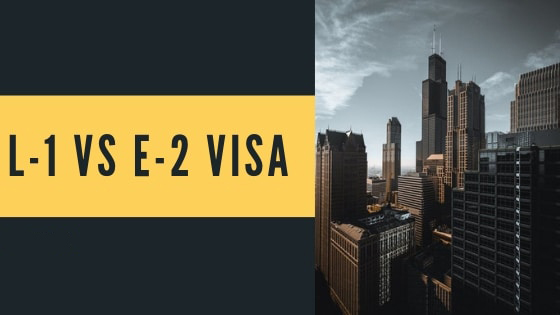Entering and working in the U.S. can be achieved under various employment visa options, and the L-1 and E-2 visas are some of the most utilized of these options. But while they both grant holders the ability to live and work in the U.S. temporarily, they have several differences that may make one more applicable to your case than the other. Let’s explore the things that differentiate these two types of visas.
What is the L-1 Visa?
The L-1 is a non-immigrant visa that allows international organizations that have offices in both the U.S. and abroad to transfer certain employees under their employment to work in their U.S, office in occupying suitable roles. The L-1 visa has two categories based on the position that is to be occupied by the employee. The two types are the L-1A and L-1B:
L-1A for Executives and Managers: This L-1 nonimmigrant category, as the name implies, is meant for employees who are executives or managers of a multinational company. It allows the company to transfer this category of employee to its affiliated U.S. office to serve in an executive or managerial role. A multinational company without an existing branch or location in the U.S., but that is in the process of starting one, may also be allowed under this L-1A category. The company could send executives and managers to the U.S. under a one-year visa for the purpose of starting a new branch.
L-1B Intracompany Transferee Specialized Knowledge: The L-1B, on the other hand, is for employees with specialized knowledge. It allows a U.S. company to transfer certain professional employees from its affiliated foreign offices to work in its U.S. office. The “specialized knowledge” stipulates that transferred employees must have some knowledge or a particular skill set crucial to the company’s service, research, equipment, management, or technique, which may not be readily available in the U.S.
Both the L-1A and L-1B require that the employer seeking to bring in the foreign employee must be the one to file the I-129 Petition for a Nonimmigrant Worker on behalf of the employee. In other words, the employer is the sponsor while the employee is the beneficiary. The L-1 visa requirements and process is a procedure which must involve both the sponsor and the beneficiary.
Unique L-1 Visa Attributes
Each visa application has some uniqueness that makes it distinct from other types, and the L-1 visa is no different. The features that distinguish the L-1 visa include:
Period of Stay: With the L-1 visa, you are allowed an initial stay of up to three years. After which, you can request an extension. The extension may be granted in increments of up to an additional two years duration. The maximum period of stay, however, is seven years for the L-1A while for the L-1B, the maximum period of stay is five years.
Family Members of L-1A Intracompany Transferee Executive or Manager: As an L-1 visa professional, you are allowed to bring your spouse and dependent children who aren’t older than 21 years old to the U.S. They will also enjoy the same period of stay as the principal beneficiary. They may also collectively seek a change of status or extension of stay by filing an I-539 Application to Change/Extend Nonimmigrant status. Apart from these, you may apply for employment authorization by filing an I-765 form and, if granted, your spouse or dependents can work in the country with very few restrictions or barriers to where they can apply to work within the U.S. (except for jobs that require security clearance)
Blanket Petitions: The L-1 visa permits certain companies to file a blanket petition. The blanket petition is very beneficial to both the employee and the organization as the company has the flexibility of transferring an employee to the U.S. quickly with short notice. With this option, the employer can file one petition covering several employees rather than filing individual petitions for each beneficiary. This saves both time and a considerable amount of money for the employer.
What is the E-2 Visa?
The E-2 visa is also nonimmigrant classification which allows nationals of any of these foreign countries that maintain treaty of commerce with the U.S to enter the U.S. mainly to invest a substantial amount of capital in a U.S. enterprise. It can be applied to two groups of people, which are E-2 treaty Investor and E-2 treaty employee.
E-2 Treaty Investor: The E-2 treaty investor refers to the individual seeking to invest a “substantial capital” in the country in a U.S. enterprise which he/she will develop and/or control. The investment could be a newly established business or already existing but newly purchased by the investor.
E-2 Treaty Employee: An E-2 treaty employee visa allows an E-2 treaty investor to bring in an alien employee to work in his/her U.S.-based company in an executive or supervisory role. However, if the employee is to serve in a lesser position, he/she must have special qualifications or skills. The employee does not have to be from the same country as the treaty investor.
Unique E-2 Visa Attributes
Here are some things that set the E-2 visa apart from other nonimmigrant work visas:
Period of Stay: With the E-2 visa, you are allowed a maximum initial stay of two years either as an investor or an employee. After the initial stay, you may request for an extension of increment of two years. The good news about this is that you may request for this two-year extension of your E-2 visa for an unlimited number of times after the first two years.
Family Members: Your immediate family members (spouse and children under 21 years of age) have the privilege of accompanying or following you, the principal beneficiary to the U.S. However, your spouse and children must have the same nationality as yours.
If they are already in the U.S., they may file a single I-539 to seek for change or extension of status. Your spouse also has the opportunity to file the I-765 for for work authorization, which if granted, will allow him or her to be gainfully employed without any restriction as to where he or she may work in the U.S.
Family Period of Stay: Your spouse and children will get to enjoy the same period of stay granted to you as the principal beneficiary. However, while you will be given automatic readmission of two-year if you travel abroad, your family members do not enjoy this automatic readmission. It is, therefore, advisable for your family to live within the means of their residence status in the U.S. They will need to understand the period of stay they have been granted, and file for an extension if they would like to continue living in the U.S. before their current status validity expires.
Terms & Conditions
As an E-2 treaty investor or employee, you may only be permitted to work according to the activity that you were approved for at the time you were granted the classification. If you want to work somewhere else, it must be with a parent company or a subsidiary of the E-2 organization under which your classification was granted in the first place.
While you may work in any of the parent or subsidiary companies, you must ensure that the position you occupy there and the terms and conditions of employment in your granted classification remain unchanged. Also, the relationship between the organization under which you were granted the classification and the parent or subsidiary company must be established.
However, you may make some changes in your personal or in your company/employment granted status, but you must notify the USCIS and go through the necessary process for the change. What constitutes a “substantial change” is defined in the terms and conditions of E-2 status. If you need to make any change in your E-2 treaty classification, whether “substantial” or “non-substantial”, try to contact an immigration attorney for legal advice to avoid running afoul of the law.
I am qualified for both visas, but which should I choose?
If you’ve read through this and realized that you are qualified for both visas, you may still be wondering which you should choose out of the two options. In light of the above details, here are some of the things you should consider if you are in such a position. The following questions might help you to make the best decision for your own case:
- What position are you coming to occupy in the company based in the U.S.?
- How long do you intend to live or work in the U.S.?
- Are you coming with your immediate family members?
- Would you want your family members to work in the U.S.?
If you are already in the U.S., you may also need to consider these questions before changing your status to either L-1 or E-2 classifications.
 Shilpa Malik
Shilpa Malik  Boris Ignachkov
Boris Ignachkov 
